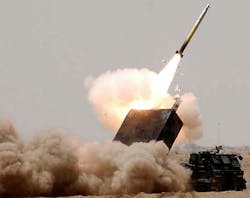Lockheed Martin to provide smart munitions for allied GMLRS long-range field artillery systems
REDSTONE ARSENAL, Ala. – Battlefield smart munitions experts at Lockheed Martin Corp. are building thousands of smart munitions for the Guided Multiple Launch Rocket System (GMLRS) field artillery for the militaries of Finland, France, Germany, and Singapore under terms of $471.7 million contract announced last week.
Officials of the U.S. Army Contracting Command at Redstone Arsenal, Ala., are asking the Lockheed Martin Missiles and Fire Control segment in Grand Prairie, Texas, to build the smart GMLRS rockets in two different versions for these allied military forces.
Lockheed Martin will build 2,868 alternative-warhead GMLRS rockets, and 648 unitary-warhead GMLRS rockets. The contract also calls for Lockheed Martin to provide 370 low-cost reduced-range practice rockets and logistics support.
The GMLRS can fire guided and unguided projectiles at targets as far away as 26 miles. The system also can fire the Army Tactical Missile System (ATACMS) at targets as far away as 190 miles. The rocket-based artillery system also can fire its munitions quickly and the move away to avoid counter-battery fire.
The GMLRS carries its guided munitions in pods that contain six rockets. Each system carries two pods that must be loaded by hand. GMLRS can fire all of its 12 munitions in less than a minute.
Related: Army surveys industry for affordable proximity sensor for GMLRS and ATACMS missile systems
The system's alternative-warhead rocket is a large airburst fragmentation warhead that explodes about 30 feet over a target area to disperse solid-metal penetrating projectiles to destroy enemy soldiers, armored vehicles, command posts, and other battlefield targets. This version has been in production since 2015.
The GMLRS unitary-warhead rocket is a GPS-guided munition with a 200-pound high-explosive warhead that can be used on open battlefields and in urban areas. Its guidance system enables the rocket to avoid causing collateral damage, and enables GMLRS crews to fire fewer rockets.
The unitary-warhead GMLRS rocket has a multi-mode fuse for point detonation, delay detonation, and proximity detonation to attacking soft targets, lightly fortified bunkers, and enemy personnel in the open.
On this contract Lockheed Martin will do the work in Grand Prairie, Texas, and should be finished by July 2019. For more information contact Lockheed Martin Missiles and Fire Control online at www.lockheedmartin.com/us/mfc.html, or the Army Contracting Command-Redstone at http://acc.army.mil/contractingcenters/acc-rsa.
Learn more: search the Aerospace & Defense Buyer's Guide for companies, new products, press releases, and videos

